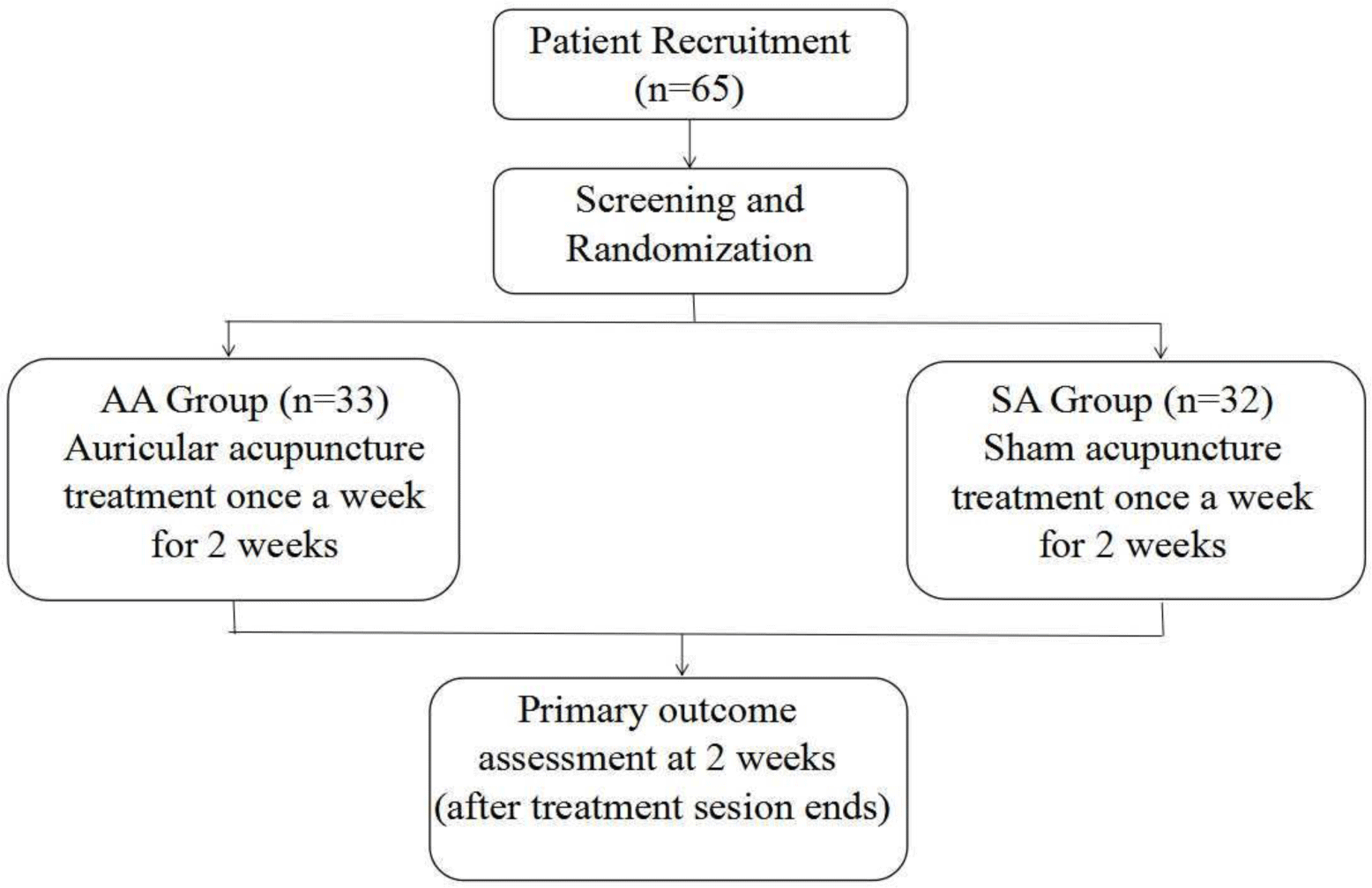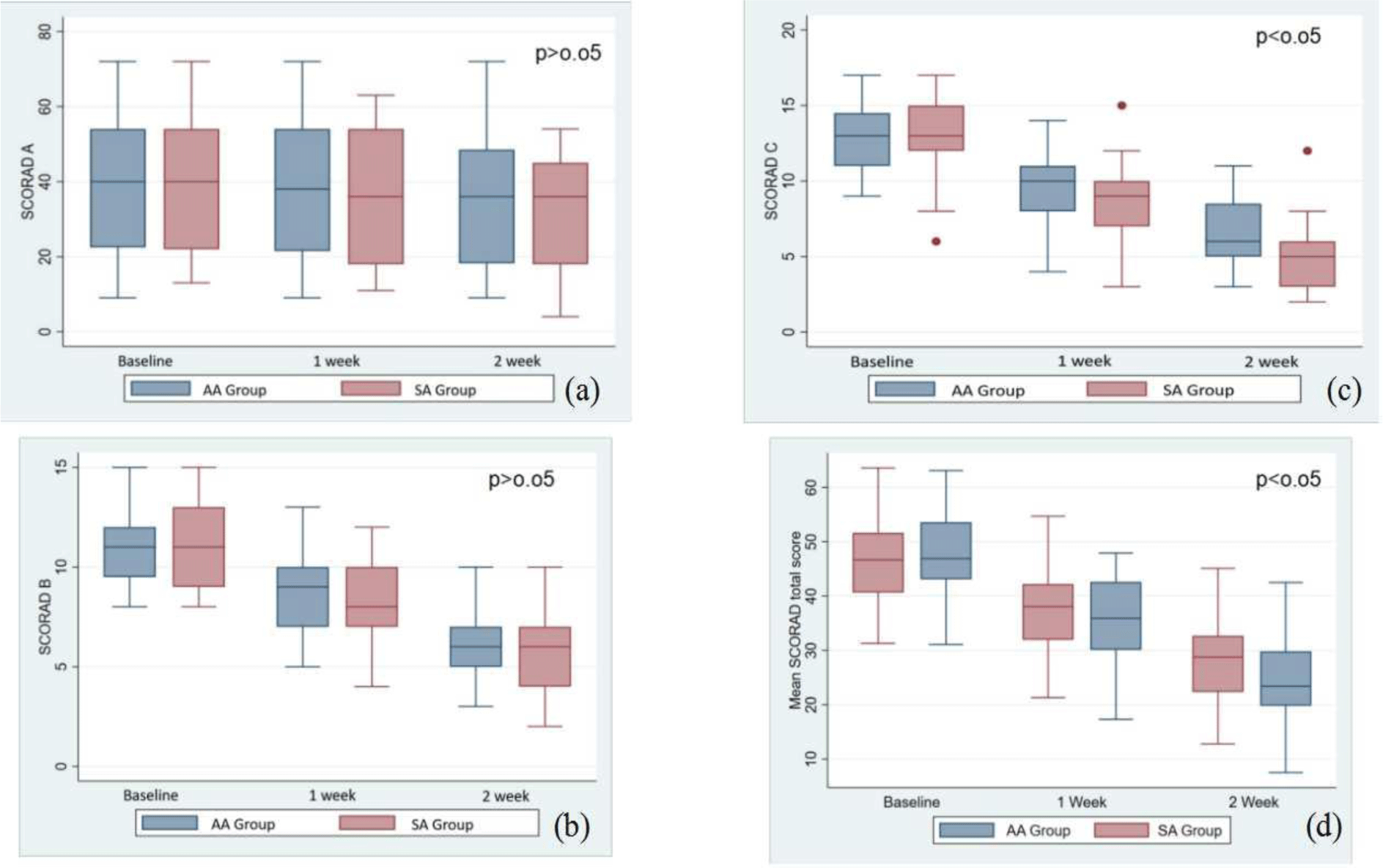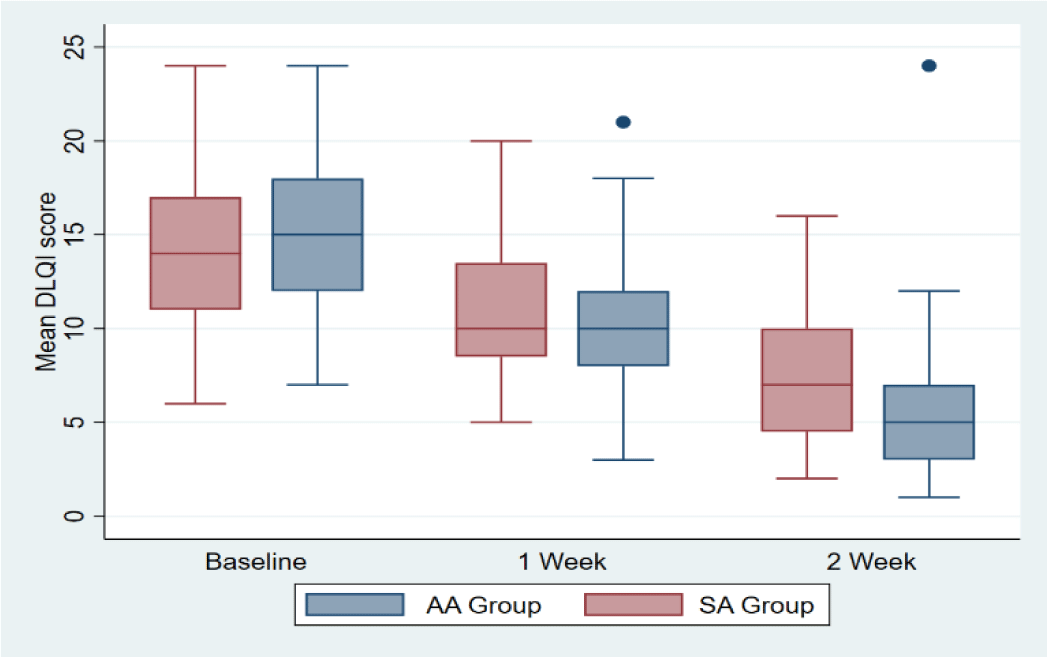1. INTRODUCTION
Atopic dermatitis (AD) is a common skin disease in dermatology, with about 15-20% of children and 1 - 10% of adults in developed countries [1,2]. The disease causes a lot of itching, so it affects the quality of sleep, the ability to work and study. Atopic dermatitis also affects the aesthetics and psychology of the patient. Statistically, atopic eczema patients have a poorer quality of life compared to other skin diseases and people in the community [3,4,5,6].
The treatment of AD includes a variety of medications, where topical corticosteroids (TCS) combined with moisturizers play a key role [7]. However, many patients are concerned about the side effects of prolonged use [8,9].
Many studies have demonstrated the effectiveness of acupuncture in reducing pruritus symptoms, improving the severity of lesions, and helping patients have a better quality of life through the DLQI (Dermatology Life Quality Index), SCORAD (Scoring Atopic dermatitis), and VAS (Visual Analogue Scale for itch),… [10,11]. Among them, auricular therapy is one of the proposed methods that are convenient and useful for patients. Wen Y’s study used auricular acupressure combined with modern medicine in patients with chronic eczema in the anus, after 2 weeks of intervention there was a significant change before and after in the degree of lesion and DLQI score [12,13]. In Vietnam, there has not been a study on the combination of modern medicine and auricular acupuncture in the treatment of eczema. Contributing to research in this field, the study was conducted to determine whether the combination of Auricular acupuncture (AA) and modern medication could improve symptoms and the quality of life for patients with Atopic Dermatitis.
2. MATERIALS AND METHOD
This is a single-blind randomized clinical study. This study was conducted on 65 AD patients at the University Medical Center Ho Chi Minh City Branch 3, Vietnam from November 2020 to May 2021. A total of 65 AD patients will be randomly assigned in a 1:1 ratio to receive two sessions once weekly of either auricular acupuncture (AA) or sham acupuncture (SA) over two weeks. The SA group is the control group and the AA group is the treatment group. They will randomly draw a sealed numbered envelope. If the number is odd, they will go to group AA, if it is even, they will go to group SA. They did not know which group they were in. Both groups were treated with cetirizine hydrochloride 10 mg orally 1 tablet and a topical glucocorticoid twice a day for 2 weeks. The treatment with hydrochloride and topical glucocorticoid was concurrent with auricular acupuncture. Participants in the auricular acupuncture (AA) group will receive twice acupuncture treatments once a week for a total of two weeks. All AA group patients will receive acupuncture needling at four points in the ear on the same side of the injury. Four points were Lung (CO14), Shenmen (TF4), Endocrine (CO18) and Adrenal (TG2p). Sterile, stainless steel, single-use acupuncture press needles (length 1.3mm, diameter 0.22mm, Suzhou Hualun Medical Appliance Co., Suzhou, China). Four needles were inserted percutaneously till 1.3 mm deep and fixed with flesh-colored adhesive tape and retained in situ, pressed continuously in 3 minutes, then remained in place for one week. Participants were instructed to self-press acupressure 3 times a day, 30 seconds each time for 3 minutes at home. Participants then came for a follow-up visit and acupuncture with the opposite ear. Participants in the sham acupuncture (SA) group will receive acupuncture treatments once a week for a total of two weeks. All SA group patients will receive sham acupuncture at four points like the AA group. Acupuncture needling will be replaced with flesh-colored adhesive tape needle-free, not penetrating the skin. In both groups, before and after each trial, patients were assessed by the team for severity of eczema using the SCORAD scale and the impact on quality of life by the DLQI score. The evaluation of the SCORAD scale is supported by a dermatologist with over 10 years of experience. The evaluation of the DLQI scale is done by face-to-face interviews. Flow chart of the study is presented in Figure 1.

The inclusion criteria were men and women over 18 years old, who were diagnosed with atopic eczema by Hanifin and Rajka criteria [14] and they agreed to participate in the study. The exclusion criteria were: Patients who have inflammation, sores in the ear skin area, history of anaphylaxis, respiratory disease, severe hypertension, or hypotension; women who are pregnant or breastfeeding; patients with other skin disorders or serious systemic disease.
- Scoring Atopic Dermatitis (SCORAD): Scoring Atopic Dermatitis (SCORAD) was used to assess the severity of eczema with the following formula: SCORAD = A/5 + 7B/2 + C. A is the extent of the lesion in %. according to the rule of 9. B includes the characteristics of redness, papules or edema, exudate or scaly discharge, abrasions, lichenification, dryness of the skin (normal skin) calculated on a scale of 0 to 3 according to the degree of severity. from zero to light, medium, heavy. C includes itching and insomnia on a scale of 1 to 10 [15].
- Dermatology Life Quality Index (DLQI): The outcome of the assessment is the change in the score of the effect of eczema on quality of life through the DLQI (Dermatology Life Quality Index), consisting of a table of 10 questions. The scores for each question are as follows: 3 points for very much influence, 2 points for much influence, 1 point for little influence, and 0 points for no influence. The DLQI score is calculated by taking the total score of each question, with a maximum of 30 and a minimum of 0. The higher the score, the worse the quality of life. [16].
- Adverse events: Adverse events of auricular acupuncture may be pain, dizziness, skin itching, bleeding,...[17]. This will be assessed during the acupuncture procedure. Appropriate actions will be taken to minimize the side effects of ear acupuncture.
With a = 0.05. b = 0.1, sample force: 0.9, so 1 – β is the sample force of the study, r = 1. Accoding to Wen Y’s study [Error! Reference source not found.], so m1 = 4.31, m2 = 7.96; s1 = 3.9, s2 = 4.52.
We calculated the sample size of each group to be 29 people. The study estimated a 10% sample loss, so a sample size of 32 people was taken for each group.
Collect data through tracking sheets. Process and analyze data using Microsoft excel 2019 and Stata 15.0 software. Report the mean (standard deviation) for the quantitative variable; the ratio for the categorical variable. The chi-squared test compares the number of men and women between two groups. Wilcoxon sign rank test compares DLQI scores and SCORAD scores before - after in each group. Wilcoxon rank-sum test: compare DLQI and SCORAD scores between 2 groups. The difference was statistically significant when p<0.05.
This study was approved by the Board of Ethics in Biomedical Research at the University of Medicine and Pharmacy at Ho Chi Minh City on September 9th 2020, No.537/HÐÐÐ-ÐHYD. All the participants signed an informed consent form in which the personal identification of research object was not reported (name, address).
3. RESULTS
In the AA group, there were 33 participants, 15 men, 18 women, the youngest age was 20 years old, the oldest age was 73 years old, the mean age was 42.8 ± 2.5, the shortest disease duration was half a year, the longest was 15 years, the mean duration was 4.9 ± 0.7. In the SA group, there were 32 participants, 14 men, 18 women, the youngest age was 19 years old, the oldest age was 92 years old, the mean age was 50.1 ± 3.0, the shortest disease duration was half a year, the longest was 11 years, the mean duration was 4.8 ± 0.5. There were no statistically significant differences between the two groups by gender, age, and duration of the disease.
The total SCORAD in the SA group from 46.4 ± 1.3 after 1 week decreased to 37.3 ± 1.3 and after 2 weeks decreased to 28.2 ± 1.2. The SCORAD total in the AA group from 47.6 ± 1.5 after 1 week decreased to 35.3 ± 1.4 and after 2 weeks decreased to 24.3 ± 1.3. Compared between the two groups, the total SCORAD score after week 1 was not statistically significant, but after 2 weeks the AA group decreased more than the SA group, and the difference was statistically significant.
After 2 weeks, the extent component of SCORAD (SCORAD A) and the intensity component of SCORAD (SCORAD B) were not significantly different between AA and SA groups, the degree of itching and sleep quality (SCORAD C) improved more in the AA group, which was significantly different from the SA group SCORAD scores in both groups improved after 1 week and lasted up to 2 weeks, a statistically significant difference from baseline.
In the SA group, the DLQI score from 14.7 ± 0.8 decreased to 11.2 ± 0.8 after 1 week, and decreased to 7.6 ± 0.7 after 2 weeks, which were statistically significant differences compared to baseline. In the AA group, the DLQI score from 15 ± 0.7 decreased to 10.6 ± 0.7 after 1 week, decreased to 5.7 ± 0.7 after 2 weeks, the difference was statistically significant compared to baseline. When comparing the two groups, the AA group had a greater improvement in scores than the SA group, the difference was statistically significant at the time after 2 weeks of the study.
The figure shows more clearly the change of DLQI scores of the two groups. After 2 weeks of study, the AA group had a greater improvement in quality of life than the SA group.
Adverse events of auricular acupuncture may be pain, dizziness, skin itching, bleeding,... However, no adverse effects were observed throughout the study.

4. DISCUSSION
There were no differences between the two groups by gender, age, duration of the disease, SCORAD score and DLQI score before the study. Thus, the research samples are identical, this ensures the accuracy and objectivity when comparing the two groups.
After 2 weeks, the extent component of SCORAD (SCORAD A), the intensity component of SCORAD (SCORAD B), the degree of itching and sleep quality (SCORAD C) improved more in the AA group. However, only the difference in SCORAD C was statistically significant. Comparing the total SCORAD score between the two groups after 2 weeks, the AA group decreased more than the SA group, and the difference was statistically significant. This result is similar to the study of Wen Y [13] and the study of Park JG [12]. In Wen Y’s study, the Auricular Acupressure (AA) group had an improvement in the degree of itching, skin lesions, lesion morphology compared with the Sham Acupuncture (SA) group, the difference was statistically significant [13]. In the study of Park JG, the SCORAD A, B and SCORAD total of the Verum Acupuncture (VA) group improved compared to the Sham Acupuncture (SA) group, the difference was statistically significant [12]. In all 3 studies, eczema severity changed from moderate-severe to mild-moderate after the end of the study. After 2 weeks of intervention, our study showed that auricular needle insertion combined with the use of modern drugs helped patients improve symptoms of itching and insomnia more than without needle insertion, but no significant change in skin symptoms was observed. The lesion morphology and symptoms on the skin need time to recover, the study of Wen Y and Park JG both took 2 to 4 weeks longer than our study, so we can see a clear difference between the two groups. The limitation of our study was that we did not continue to monitor the patient’s improvement after 2 weeks of the study. Longer follow-up studies are needed to further evaluate patient improvement.
In the study of author Wen Y [13], the Auricular Acupressure group was more effective in reducing DLQI than the Sham Acupressure group. After two weeks, the DLQI score of the Auricular Acupressure group before the study was 17.62 ± 5.39, reduced to 4.31 ± 3.9 compared to the Sham Acupressure group before the study was 17.83 ± 5.78 decreased to 7.96 ± 4.52. In our study, the DLQI score of the Auricular Acupuncture group before the study was 15 ± 0.7, reduced to 5.7 ± 0.7 compared to the Sham Acupuncture group before the study was 14.7 ± 0.8 decreased to 7.6 ± 0.7. Both studies used modern medicine as a foundation and combined with Auricular Therapy, had a mean DLQI score of more than 15 points before and improved after treatment. These results suggest that in addition to using modern medication treatment combine with Auricular Therapy for 2 weeks is equally effective in improving the quality of life in patients with AD.
In our study, the DLQI score was highest in question number 1 (symptoms of itching, pain, skin stinging) and question number 2 (embarrassing, loss of confidence) in both groups. Before the study, in group SA, the score of question 1 was 2.7 ± 0.1, the score of question 2 was 2.3 ± 0.1; in group AA, the score of question 1 was 2.7 ± 0, 1, the score for question 2 is 2.2 ± 0.1. This score is similar to the study of author Huang J [18] which conducted a systematic review of the quality of life in eczematous disease in Asian countries and showed that the majority of patients who complained of major discomfort of eczema are the pruritic and emotional symptoms brought on by the disease, followed by sleep, entertainment, and treatment inconvenience. After 2 weeks of intervention, in each group, the scores of 10 questions all decreased compared to the baseline, the difference was statistically significant. When comparing two groups, the score of question number 1 (symptoms of itching, pain, skin stinging) in the AA group decreased more than in the SA group, the difference was statistically significant. Thus, the use of auricular acupuncture brings more comfort to the patient and reduces itching symptoms more than without AA.
Adverse events of auricular acupuncture may be pain, dizziness, skin itching, bleeding,...However, no adverse effects were observed throughout the study. This is similar to the study of author Wen Y [13]. Therefore, Auricular Therapy is a safe method for eczema patients.
The symptoms of eczema according to traditional medicine are related to the function of the lung, so CO14 is the first suitable choice [13,19,20]. Recurrent episodes of eczema are related to stress, psychological anxiety. TF4 is an ear point recognized and used in the treatment of almost all ailments including pain, inflammation, sedation, addiction treatment. TF4 is related to the psychological, nervous, and emotional systems of the body, so it can relieve anxiety, fear, anxiety, and help regulate the nervous system and prevent itching [21,22,23]. TG2p and CO18 have been reported to modulate humoral and nervous immunity, treat dermatitis, and also have anti-allergic functions [21,24]. Hence, these four acupoints including CO14, TF4, CO18, and TG2p can be recommended as priority choices for AD. The study found no adverse effects of AA during the study. So, combining auricular acupuncture CO14, TF4, CO18, and TG2p points and modern medication treatment is safe for AD patients.
Current studies have discovered that the possible mechanisms of atrial acupuncture for itch relief are as follows: Nilsson et al found that local electrical stimulation of the skin can inhibit the nerves in the gray matter of the spinal cord by activating myelinated nerve fibers through presynaptic or postsynaptic neuronal inhibition, thereby inhibiting pruritus [25]. We then speculated that stimulation of local acupoints might also play a role through this mechanism. In addition, stimulation of acupoints produces pain sensation, which can activate nociceptors and activate the central analgesia system through neurotransmission, thereby reducing itching. This is the same mechanism as scratching or rubbing to relieve itching [26].










